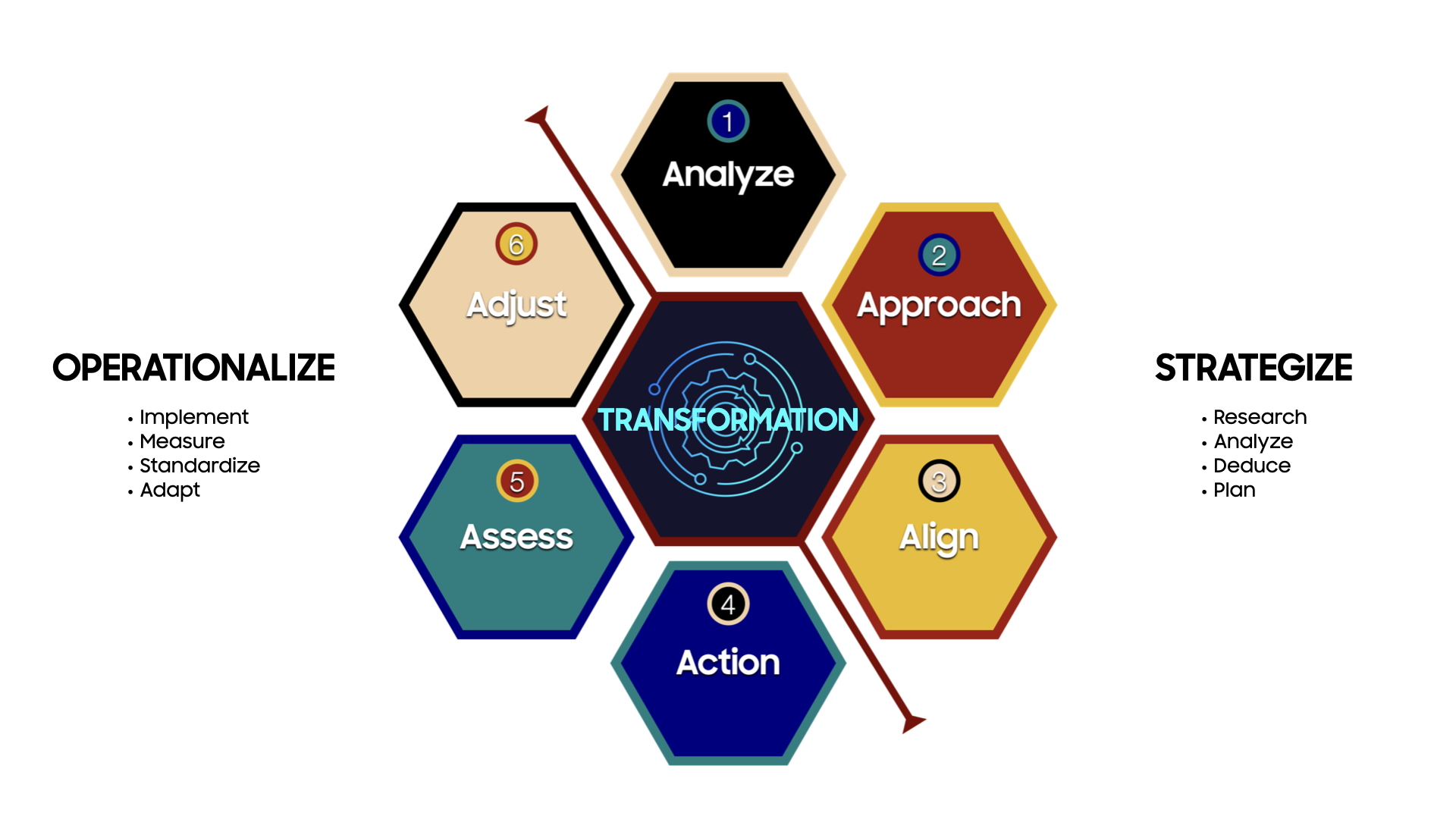The business environment is constantly changing now more so than ever. The result of this is that organizations need to adapt and overcome to remain competitive in the marketplace. Therefore, leaders must master the art and science of change management. Leading change in a changing environment is a challenging endeavor without the requisite process to smooth the transition. Change is a necessary part of business, yet more than half of businesses are unsuccessful when it comes to change. Change takes time, persistence, and consistent review of strategic change initiatives and outcomes to become a lasting part of the company. Leaders need a detailed and structured system to accomplish organizational and transformative change. At Sabacon Consulting, we utilize our very own six-step methodology which we call the Intentional Management System. Many studies have been conducted on change management, however, one study, “Successful Organizational Change,” sticks out because of the detailed review of seven change management methodologies.
When is Change Required?

According to Jeroen Stouten, Denise Rousseau and David De Cremer, the authors of “Successful Organizational Change,” change is required of businesses when there are technological advancements, new workforce demands, minimal barriers to entry, political swaps, social upheavals, economic uncertainty, and globalization just to name a few. Business leaders need to understand these shifts to make meaningful change, otherwise they run the risk of their businesses losing market share and having continuity issues. Change in this context is the planned organizational transformation as a set of deliberate activities that move an organization from its present state to a future state. What changes are you looking to make in your organization and why? Let us know down below.
The Intentional Management System, Our Change Process

All businesses benefit from strategic development and performance management, especially in a changing environment. Leaders must recognize when change is needed. They must develop a change mindset, establish a change strategy and administer a performance management system, so leaders pay close attention to each step.
Strategize

1. Analyze the Situation: Gather, Analyze and Comprehend all the information (both internal and external to the organization) necessary to design an effective strategic change Approach to benefit stakeholders.
a. At Sabacon Consulting, we believe the first step to change an organization is to analyze the situation at different levels and through different means such as: SWOTT, PEST, 7S, and financial analyses. Additionally, we take into consideration benchmarking, management, employees, and customers surveys to ensure we understand the full scope of the issue. A detailed analysis of the situation is the foundation for successfully creating transformational change.
b. It is also critical to analyze the organization’s readiness for change. There are three facets of readiness that we review to ascertain the organization’s readiness: prior history with change, current employee stress levels and leadership’s ability to implement change. Each facet of can present a challenge to success. Therefore, we suggest identifying and rectifying the impediments to organizational readiness as early as possible.
2. Formulate a Compelling Strategic Approach for Change: Engineer a data-driven strategic change Approach to attain the stated goals and remodel the organization
a. The leadership team, after reviewing and comprehending the data, must create a vision for the future. The vision for change must be clear and concise and leaders must be transparent to all about the reasons for change.
b. Almost simultaneously, leaders must assemble an Eagle Team (a guiding council) comprised of team members who have shared values, enthusiasm, strong communication abilities, and represent a cross section of the organization. The Eagle Team should be tasked with working with leadership to design a strategic change Approach and spreading the vision, dealing with objections, and motivating others.
c. The Eagle Team, leaders, and consultants, after developing a strategic change Approach must delineate the initiatives that will become the action plan, but that is not the end of the process. The aforementioned group must then develop SMART goals to measure each initiative’s progress and a company Performance Dashboard to centralize all of the initiatives and goals.
3. Coordinate All Aspects of the Organization to Align the strategic change Approach Throughout the Organization: Institutionalize the strategic change Approach to ensure its success by incorporating it into the organizational, budgetary, and operational plans.
a. This is where the rubber meets the road as the cliché goes. All the time, energy and costs allocated to developing a strategic approach will be wasted without purchasing the products and services, providing the proper incentives, creating the appropriate budgets, and organizing the staff to deliver the desired outcomes.
b. My mother always said, “measure twice cut once.” At Sabacon Consulting, we couldn’t agree more. This is the last opportunity to make modifications before the initial rollout of the new strategy. Therefore, the leadership and Eagle Teams, and consultants must review all the initiatives, goals, products, services, incentives, and budgets. They must also answer the questions is the staff appropriately trained and capable of executing the strategic change Approach and does the staff have the skills and competencies necessary.
c. Effective change goes hand in hand with training on new skill sets, competencies, and knowledge. There will be fewer barriers and resistance to change when all the team members have the skills and competencies necessary to produce the change.
d. Lastly, the Eagle Team must establish a communications plan to reach all corners of the organization with the justification for change, the strategy to bring about that change, the part each and every person will play to produce positive outcomes, and the incentives for reaching those outcomes.
Operationalize

4. Execute the strategic change Approach to change by taking Action on each of its initiatives: Implement the tactics necessary to push the change strategy towards its stated goal.
a. Open communication is critical for effective change management. As mentioned earlier, having, and carrying out the communications plan is critical to the success of the strategic change Approach. Leaders must continuously communicate the rationale for change, through their vision, mission, and plan for effectuating the change. Additionally, they must explain the part each employee must play to achieve the organization’s goals and address the fears that can sometimes paralyze the organization.
b. Leadership and the Eagle Team must prioritize all the initiatives, assign responsibilities, and develop milestones to set the organization up for success.
c. The greatest strategic plan is worthless, if the staff is unaware of the plan or the part, they play in bringing the strategy to fruition. For that reason, leaders must deploy the Eagle Team throughout the organization to promote the change strategy, answer questions, tackle challenges and be a conduit to the leadership team.
d. Once everyone comprehends the reasons behind the change, leaders can finally begin to move forward by implementing the change strategy. Leaders must motivate their teams to act and continue to execute the strategic change Approach as the change begins to occur.
e. Now, is when leaders must empower their people and encourage their inventiveness so long as it aligns with the organization’s strategic change initiatives and goals. Afterall, at this point, there has been a lot of time, money and energy invested in transforming the organization, but this is not the time to micromanage your staff or constrict their creativity. There can be a tendency to hold authority and decision-making close to the top for fear of making mistakes when leaders are faced with transformational change. This trap must be avoided at all costs.
f. The day-to-day procedures and communication should reflect the change. Management should stay vigilant to solve issues as they arise. Put simply, leaders must get down to managing the business.
5. Assess the Effectiveness of the Strategic Rollout: Evaluate the execution of the strategic change Approach, its objectives, and initiatives by measuring the progress the organization has made against the KPIs, goals, outcomes, and financial targets on the company Performance Dashboard.
a. Many companies fail to effectively implement change because leaders neglect consistent oversight of the progress made. The organization must begin to hold routine status meetings, especially, if their leaders are not in the habit of doing so. Leadership must examine the headway made on each of the initiatives on the organization’s Performance Dashboard.
b. Leaders must be supportive as team members work through the data. This is a time for management to fully utilize the new information to enact the change the organization seeks.
c. Management will realize that there have been many successes and some challenges once status meetings become routine. Successes and challenges both must be addressed. The successes must be lionized to assist in creating company lore and the challenges must be subdued to continue the advancement of the strategy to bring about change. Change takes time. Leaders can’t expect their entire team to fulfill the change management goals overnight. Accordingly, Leaders must celebrate small wins and communicate to their team members that they are on the right track. This is key to long-term success. Additionally, celebrating small wins will help solidify the new culture throughout your company as team members share successes together.
d. Once again communication is key. C-suite leaders and mid-level managers must learn to consistently and effectively report both up and down the organization. These leaders must ensure that everyone understands the progress that has been made and what is still left undone.
6. Adjust the strategic change Approach Based on New Information: Garner additional information about tactical successes and challenges. Examine the results against benchmarks, financial results, organizational metrics, and goals and actively seek out change for the better.
a. Leaders must be relentless in removing obstacles for the realization of the change strategy. As new team members are brought on, leaders must make sure they are trained on the new processes and not old methods.
b. Flexibility is the key to success. Leaders being flexible to change initiatives as well as KPIs, and targets is mandatory to honing the strategy. Leaders adding new initiatives or removing initiatives is also welcome so long as the new initiatives align with the overall change strategy.
c. Finally, and above all, leaders must not become complacent. Leaders, who possess strong change management skills and competencies, adapt, and mold the change strategy to secure long-term success. They have a hunger for change and spread that hunger throughout the organization
Next Steps

Change management can be a daunting task, especially, if you are considering implementing large-scale transformational change. This is where a qualified expert, like Sabacon Consulting, can assist. Sabacon Consulting is an expert on change management, helping a multitude of clients create meaningful and lasting change. Having an expert to turn to when the change isn’t a smooth transition gives you the resources needed to adapt, adjust, and overcome challenges. Reach out to Sabacon Consulting today to see the success you can achieve with a qualified consultant by your side.
Sources
De Cremer, David, Rousseau, Denise, and Stouten, Jeroen. “Successful Organizational Change: Integrating the Management Practice and Scholarly Literatures.” Academy of Management Annals, 30 April 2018.

